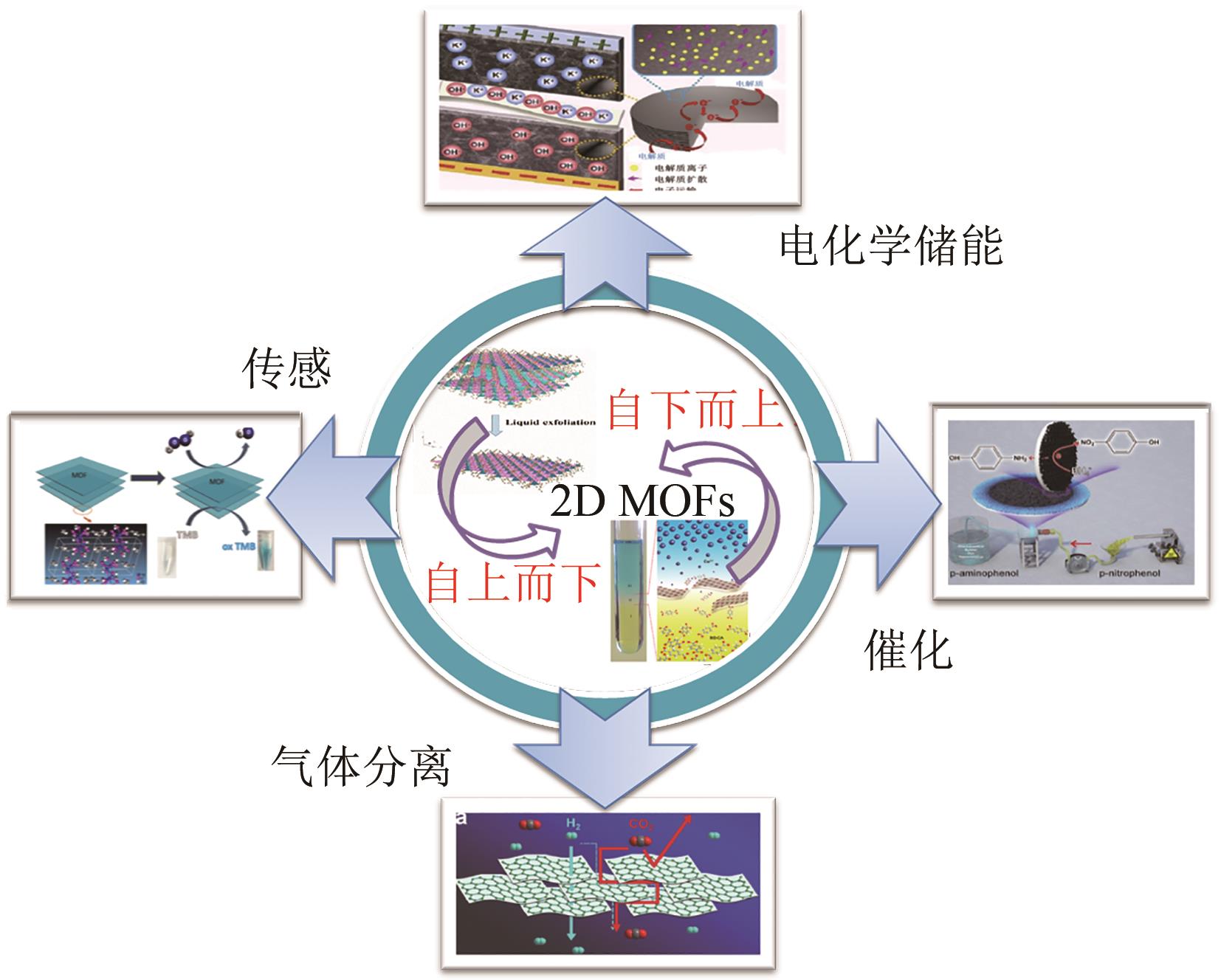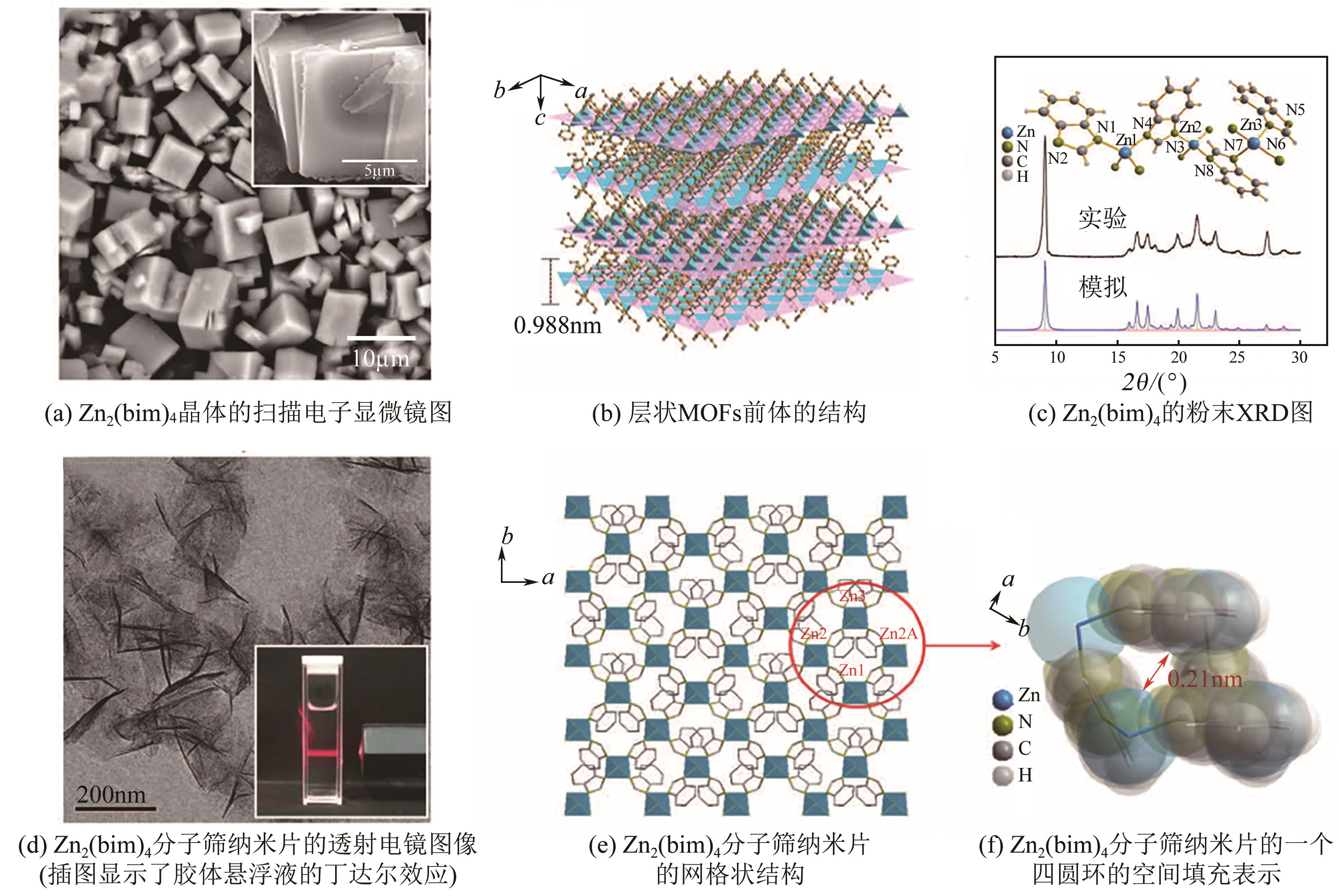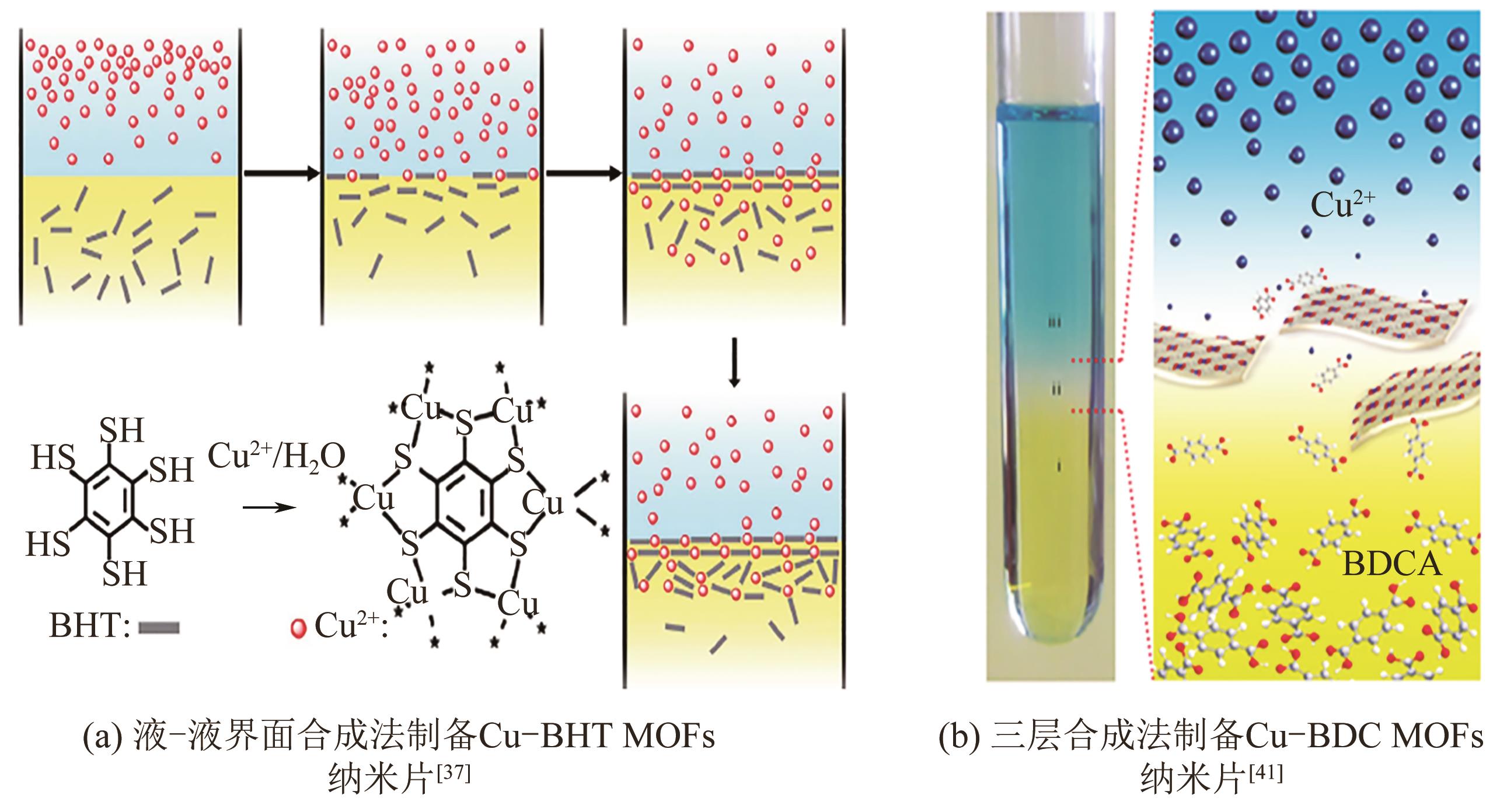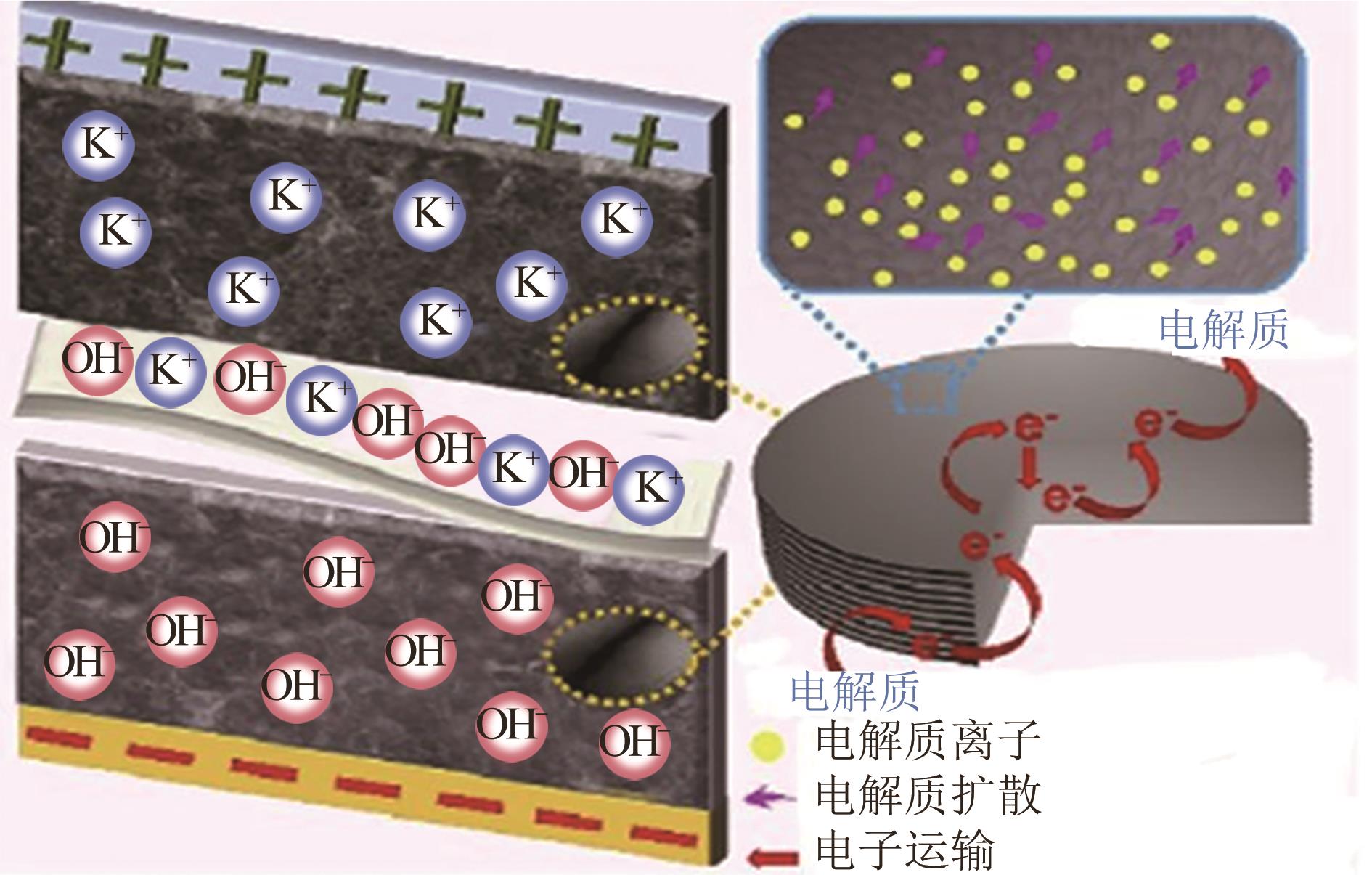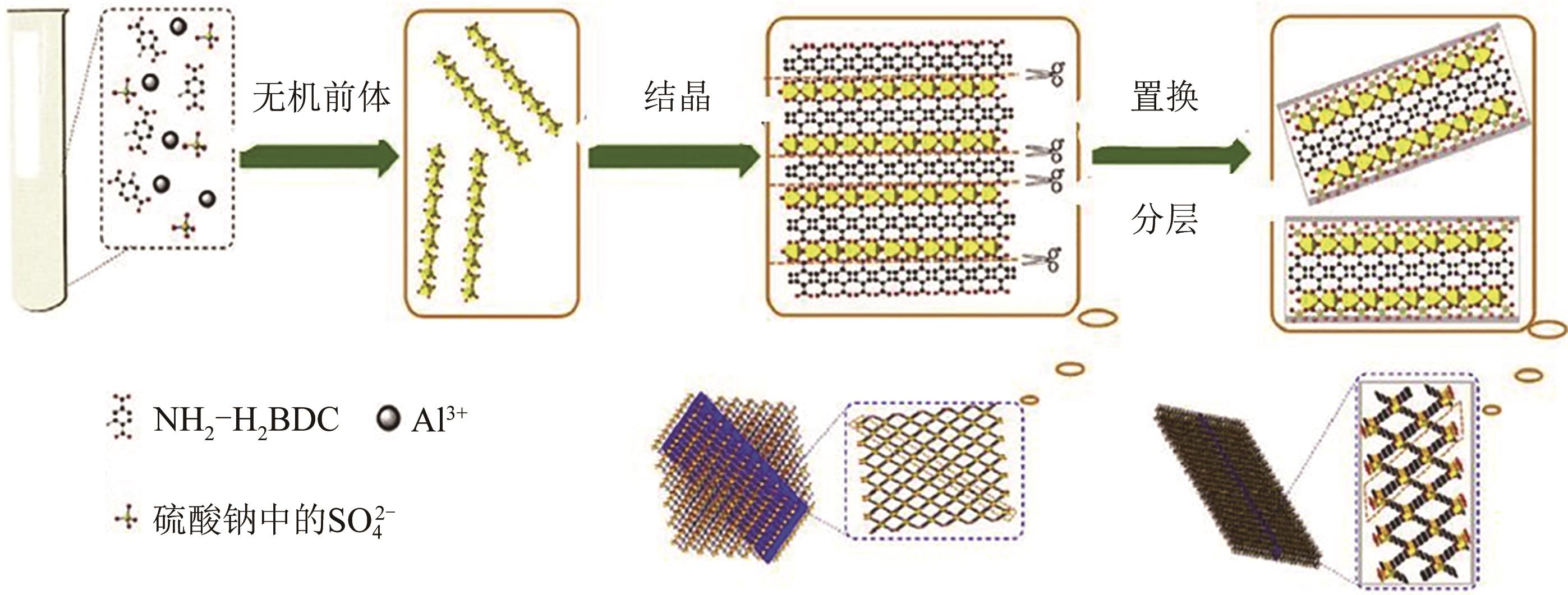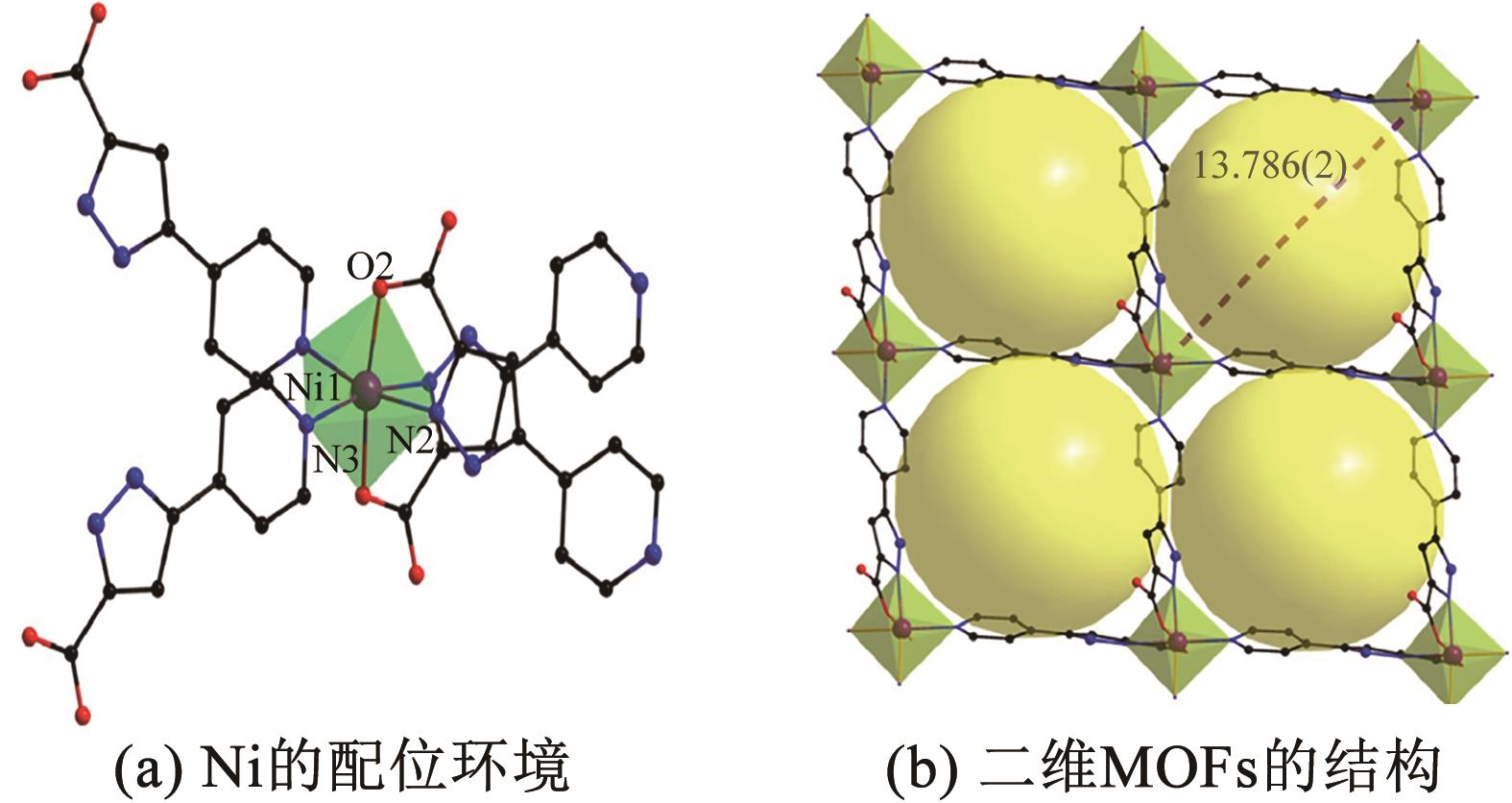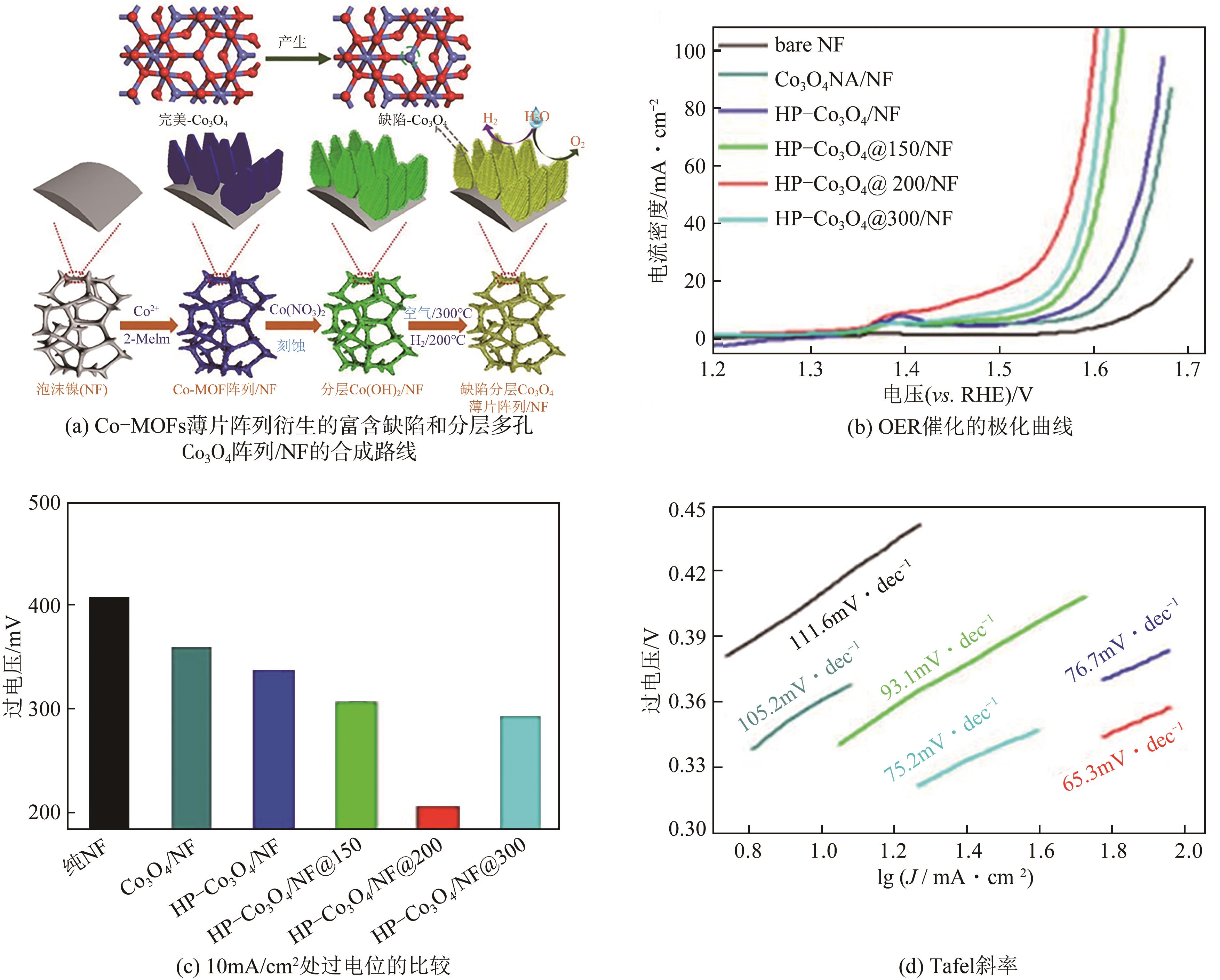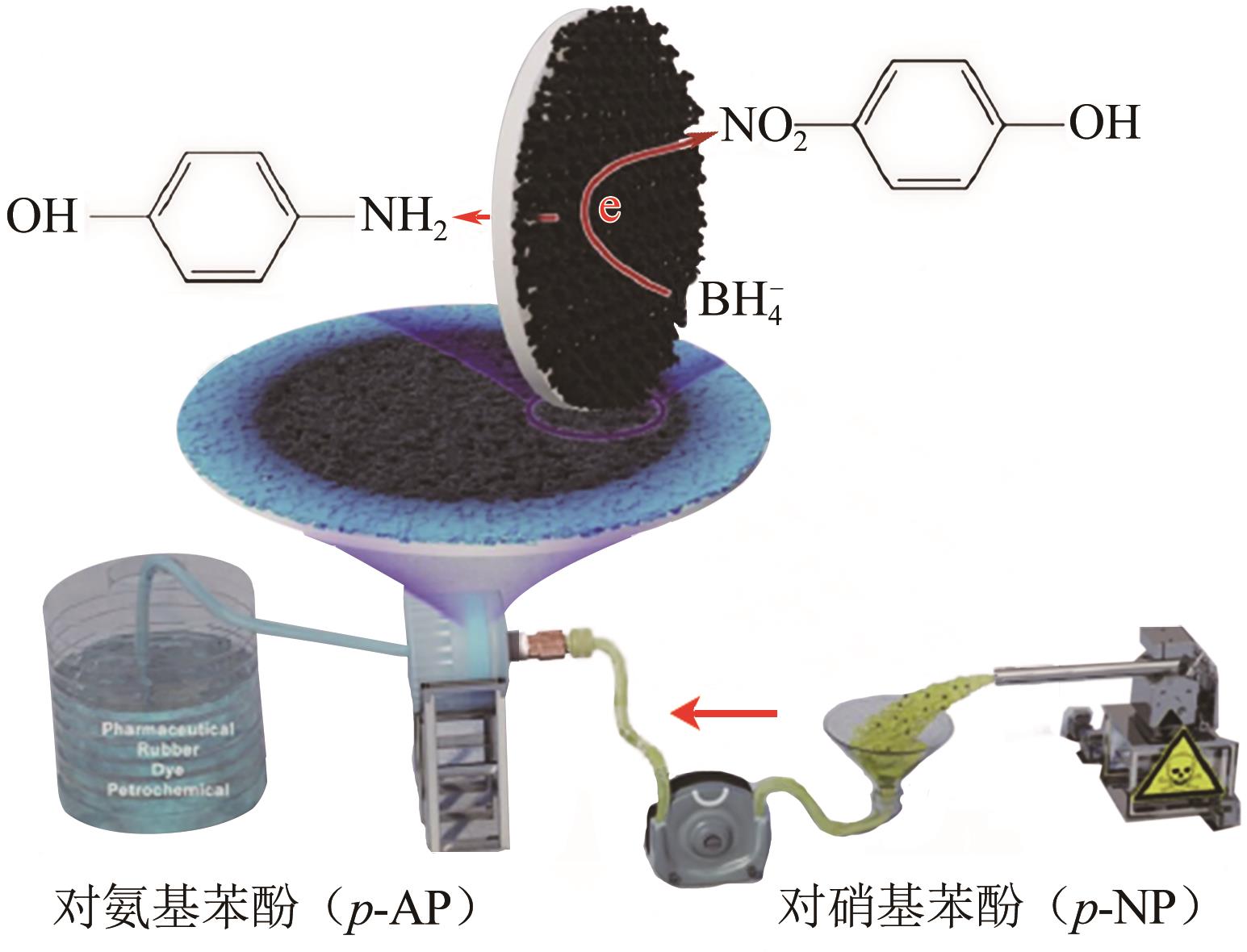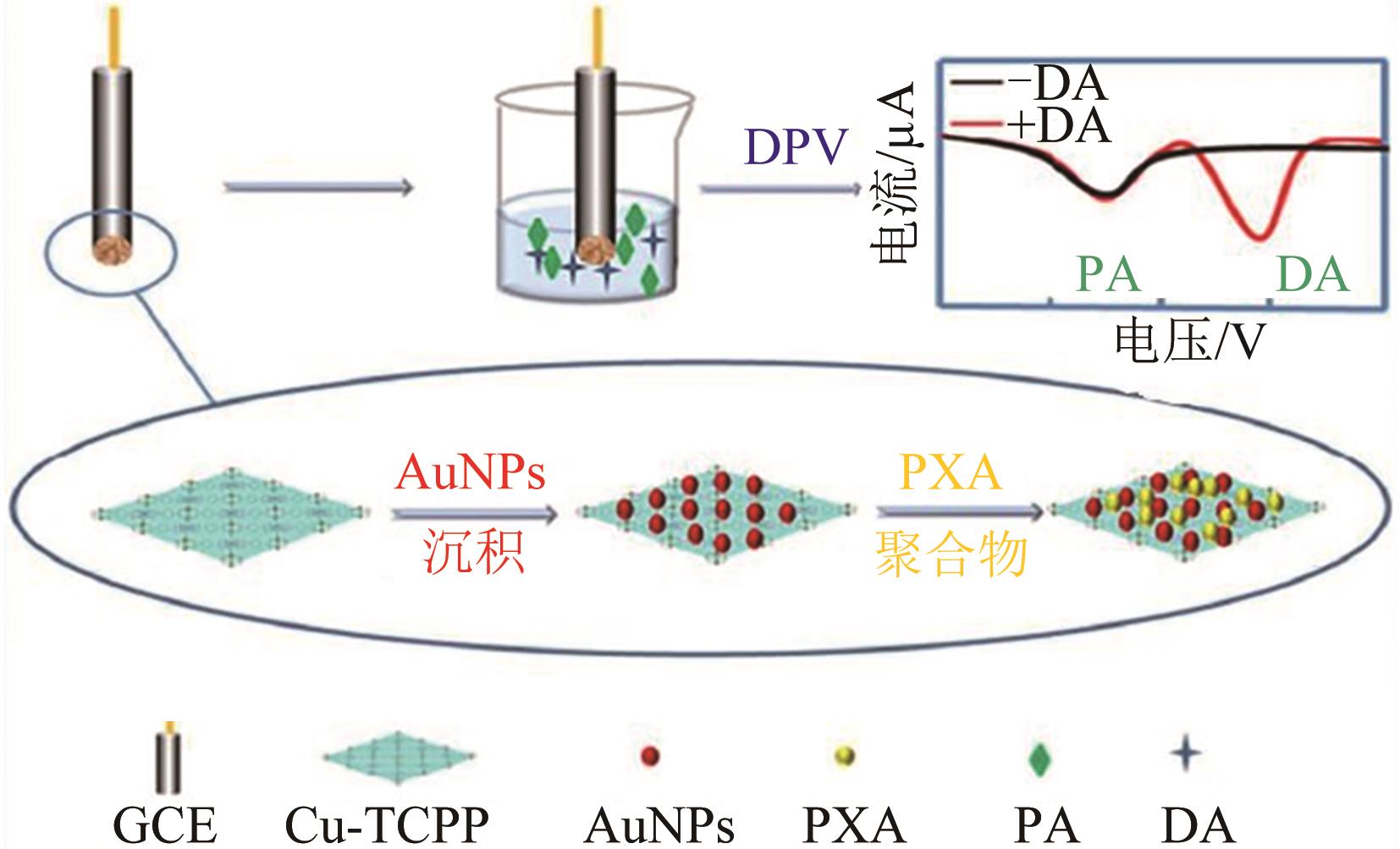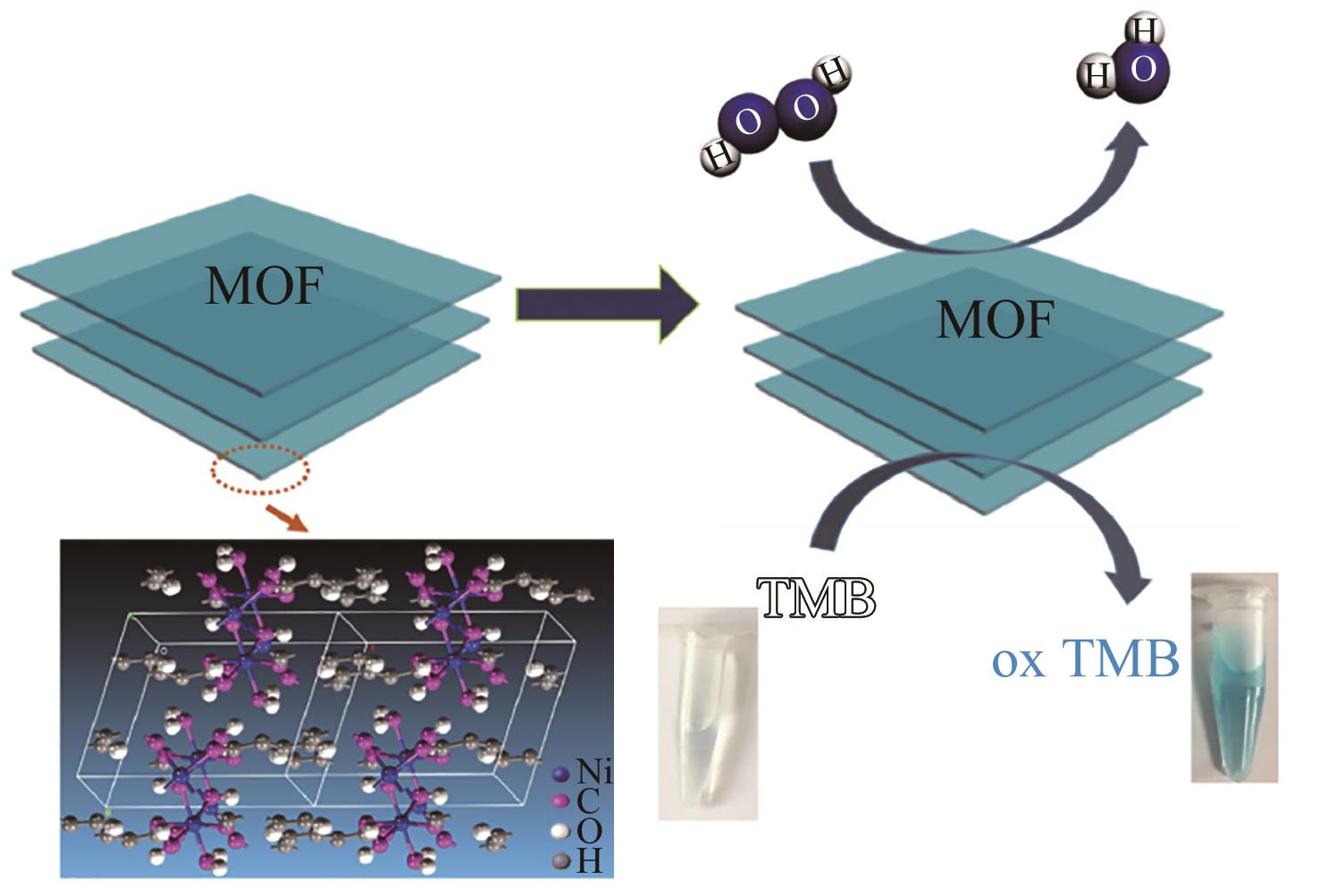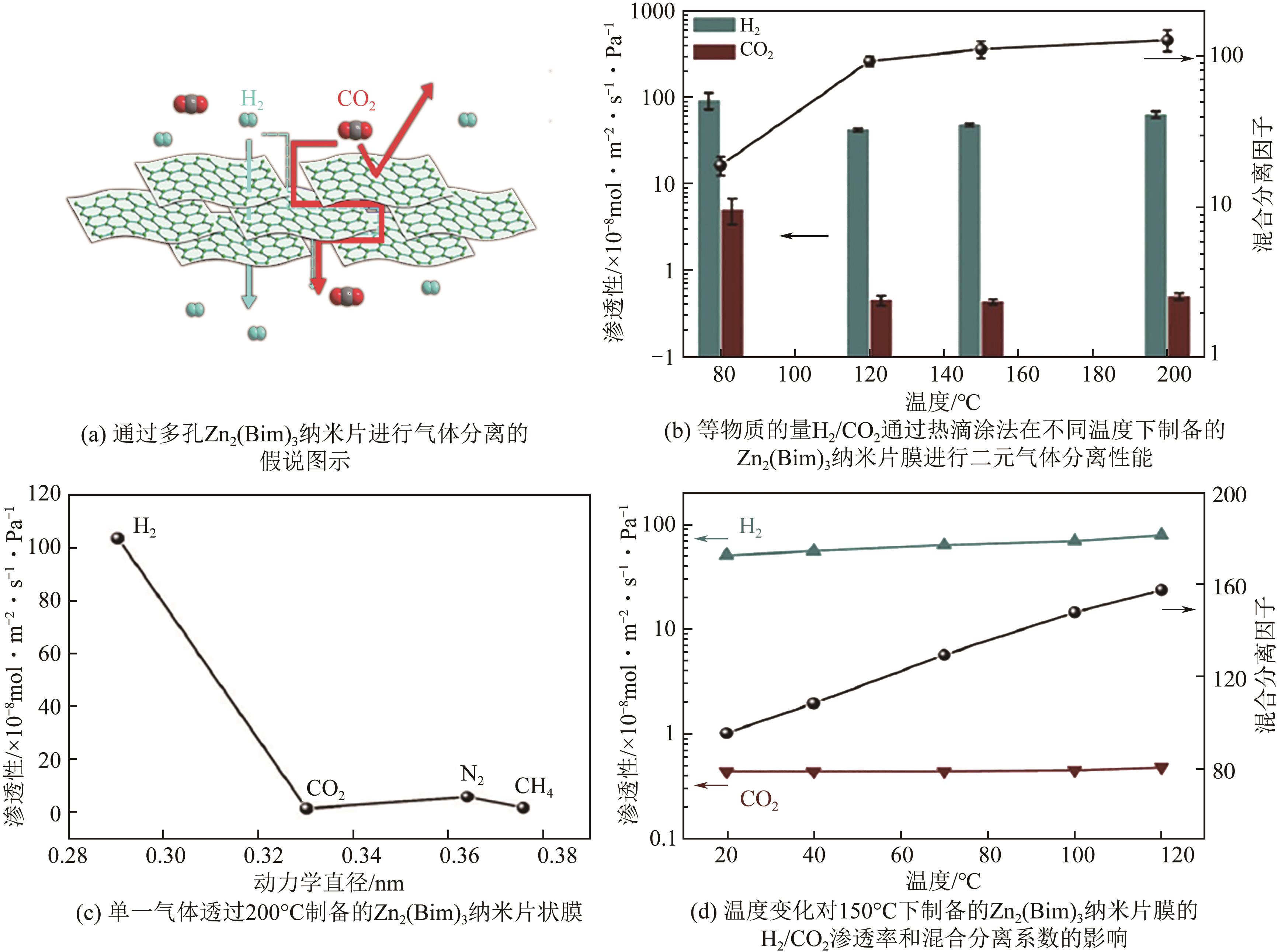化工进展 ›› 2021, Vol. 40 ›› Issue (11): 6195-6210.DOI: 10.16085/j.issn.1000-6613.2020-2288
二维金属有机框架材料的制备及其应用
张素珍1( ), 杨蓉2(
), 杨蓉2( ), 龚乐1, 樊潮江2, 燕映霖1, 许云华2,3
), 龚乐1, 樊潮江2, 燕映霖1, 许云华2,3
- 1. 西安理工大学理学院,复合材料及其产品智能制造技术国际联合研究中心,陕西 西安 710048
2. 西安理工大学材料科学与工程学院,陕西 西安 710048
3. 榆林学院化学与化工学院,陕西 榆林 719000
-
收稿日期:2020-11-16修回日期:2021-02-08出版日期:2021-11-05发布日期:2021-11-19 -
通讯作者:杨蓉 -
作者简介:张素珍(1996—),女,硕士研究生,研究方向为电化学。E-mail:1626867242@qq.com 。 -
基金资助:国家国际科技合作专项(2015DFR50350);国家自然科学基金(51702256);中国博士后面上项目(2019M653706);陕西省科技厅“创新人才推进计划-科技创新团队”项目(2019TD-019);陕西省创新能力支撑计划-国际科技合作基地(2018GHJD-17);西安理工大学校级项目(xsz2002)
Research on preparation and application of 2D MOFs
ZHANG Suzhen1( ), YANG Rong2(
), YANG Rong2( ), GONG Le1, FAN Chaojiang2, YAN Yinglin1, XU Yunhua2,3
), GONG Le1, FAN Chaojiang2, YAN Yinglin1, XU Yunhua2,3
- 1. International Research Center for Composite and Intelligent Manufacturing Technology, School of Science, Xi’an University of Technology, Xi’an 710048, Shaanxi, China
2. School of Materials Science and Engineering, Xi’an University of Technology, Xi’an 710048, Shaanxi, China
3. School of Chemistry & Chemical Engineering, Yulin University, Yulin 719000, Shaanxi, China
-
Received:2020-11-16Revised:2021-02-08Online:2021-11-05Published:2021-11-19 -
Contact:YANG Rong
摘要:
二维金属有机框架(MOFs)作为一类新型的二维多孔材料,具有厚度小、比表面积大、孔隙率高、可接触活性位点丰富等优点,在众多领域都具有研究和潜在的应用价值。本文简要综述了近年来二维MOFs的制备方法,包括“自上而下”和“自下而上”两种策略。自上而下法操作简单,有广泛的适用性;自下而上法可以通过控制实验条件在一定程度上实现对材料的可控制备。阐述了二维MOFs在电化学储能、催化、传感、气体分离等领域的应用研究。深层剖析了二维MOFs的特性对储能器件电化学性能以及反应催化活性的影响。此外,二维MOFs的高电导率和电荷转移率还促进了其在电化学传感器方面的发展;基于二维MOFs的分子筛膜也越来越受到研究人员的关注。最后指出了二维MOFs存在易团聚、厚度难以精确控制、制取成本较高、产率偏低等问题,提出了解决方案及其未来的发展方向。
中图分类号:
引用本文
张素珍, 杨蓉, 龚乐, 樊潮江, 燕映霖, 许云华. 二维金属有机框架材料的制备及其应用[J]. 化工进展, 2021, 40(11): 6195-6210.
ZHANG Suzhen, YANG Rong, GONG Le, FAN Chaojiang, YAN Yinglin, XU Yunhua. Research on preparation and application of 2D MOFs[J]. Chemical Industry and Engineering Progress, 2021, 40(11): 6195-6210.
| 制备方法 | 优点 | 缺点 | 参考文献 |
|---|---|---|---|
| 自上而下 | |||
| 物理剥离法 | 广泛的适用性、产物高度结晶、有较大的平面尺寸 | 剥离过程缺少精度,可控性或可重复性差 | [ |
| 化学剥离法 | 产率得到了提升,在一定程度上提高了可重复性 | 难以控制材料的厚度和尺寸 | [ |
| 自下而上 | |||
| 溶剂热法 | 可获得具有良好分散性的高纵横比纳米片 | 反应时间相对较长 | [ |
| 界面合成法 | 条件较温和,可以在常温常压下进行 | 界面区域面积有限,二维MOFs纳米片产量较低 | [ |
| 辅助合成法 | 快速高效,可调节 | 辅助剂一般较难去除 | [ |
| 二维氧化物牺牲法 | 制备的纳米片厚度较小 | 需选择合适的牺牲模板 | [ |
表1 2D-MOFs制备方法比较
| 制备方法 | 优点 | 缺点 | 参考文献 |
|---|---|---|---|
| 自上而下 | |||
| 物理剥离法 | 广泛的适用性、产物高度结晶、有较大的平面尺寸 | 剥离过程缺少精度,可控性或可重复性差 | [ |
| 化学剥离法 | 产率得到了提升,在一定程度上提高了可重复性 | 难以控制材料的厚度和尺寸 | [ |
| 自下而上 | |||
| 溶剂热法 | 可获得具有良好分散性的高纵横比纳米片 | 反应时间相对较长 | [ |
| 界面合成法 | 条件较温和,可以在常温常压下进行 | 界面区域面积有限,二维MOFs纳米片产量较低 | [ |
| 辅助合成法 | 快速高效,可调节 | 辅助剂一般较难去除 | [ |
| 二维氧化物牺牲法 | 制备的纳米片厚度较小 | 需选择合适的牺牲模板 | [ |
| 2D-MOFs材料 | 衍生材料 | 应用器件 | 性能 | 参考文献 |
|---|---|---|---|---|
| Cu-MOFs | APC | 超级电容器 | 0.5A·g-1下比电容为260.5F·g-1 | [ |
| CuI-MOFs | — | 超级电容器 | 1.0A·g-1下比电容为828F·g-1 | [ |
| Al-MOFs | AMn | 锂离子电池 钠离子电池 | 0.1C下100次循环后比容量为825mA·h·g-1 0.1C下100次循环后比容量为193mA·h·g-1 | [ |
| Al-BDC | CPC | 超级电容器 | 1mV·s-1下的比电容为323F·g-1 | [ |
| NH2-MIL-53(Al) | SNO-HCN | 钠离子电池 | 50mA·g-1下比容量为522mA·h·g-1 | [ |
| Zn(bim)(OAc) | UT-CNS | 超级电容器 锂离子电池 | 10A·g-1下比电容为278F·g-110A·g-1下比容量为553mA·h·g-1 | [ |
| [Ni(Hppza)2] n | — | 超级电容器 | 0.5mV·s-1下比电容为184F·g-1 | [ |
表2 2D-MOFs材料及其衍生物在电化学储能器件中的应用
| 2D-MOFs材料 | 衍生材料 | 应用器件 | 性能 | 参考文献 |
|---|---|---|---|---|
| Cu-MOFs | APC | 超级电容器 | 0.5A·g-1下比电容为260.5F·g-1 | [ |
| CuI-MOFs | — | 超级电容器 | 1.0A·g-1下比电容为828F·g-1 | [ |
| Al-MOFs | AMn | 锂离子电池 钠离子电池 | 0.1C下100次循环后比容量为825mA·h·g-1 0.1C下100次循环后比容量为193mA·h·g-1 | [ |
| Al-BDC | CPC | 超级电容器 | 1mV·s-1下的比电容为323F·g-1 | [ |
| NH2-MIL-53(Al) | SNO-HCN | 钠离子电池 | 50mA·g-1下比容量为522mA·h·g-1 | [ |
| Zn(bim)(OAc) | UT-CNS | 超级电容器 锂离子电池 | 10A·g-1下比电容为278F·g-110A·g-1下比容量为553mA·h·g-1 | [ |
| [Ni(Hppza)2] n | — | 超级电容器 | 0.5mV·s-1下比电容为184F·g-1 | [ |
| 2D-MOFs材料 | 衍生材料 | 催化反应类型 | 过电势/mV | Tafel斜率/mV·dec-1 | 电流密度/mA·cm-2 | 参考文献 |
|---|---|---|---|---|---|---|
| Cu-BDC | CuS@C | HER | 128 | 44 | 10 | [ |
| Co-MOFs | Gr@Co-MOFs | HER | 125 | 91 | 10 | [ |
| Co-MOFs | MoS2/Co-MOFs | HER | 262 | 51 | — | [ |
| Co-MOFs | Co3O4 | OER | 205 | 65.3 | 51 | [ |
| NiCo-MOFs | — | OER | 310 | — | 10 | [ |
| NiFe-UMNs | — | OER | 260 | 30 | 10 | [ |
表3 2D-MOFs材料及其衍生物在电催化中的应用
| 2D-MOFs材料 | 衍生材料 | 催化反应类型 | 过电势/mV | Tafel斜率/mV·dec-1 | 电流密度/mA·cm-2 | 参考文献 |
|---|---|---|---|---|---|---|
| Cu-BDC | CuS@C | HER | 128 | 44 | 10 | [ |
| Co-MOFs | Gr@Co-MOFs | HER | 125 | 91 | 10 | [ |
| Co-MOFs | MoS2/Co-MOFs | HER | 262 | 51 | — | [ |
| Co-MOFs | Co3O4 | OER | 205 | 65.3 | 51 | [ |
| NiCo-MOFs | — | OER | 310 | — | 10 | [ |
| NiFe-UMNs | — | OER | 260 | 30 | 10 | [ |
| 1 | 魏游超, 许庆斗, 张凯 . MOFs材料制备方法的研究进展[J]. 高分子通报, 2018(8): 33-36. |
| WEI Youchao , XU Qingdou , ZHANG Kai . Progress in synthetic methods of MOFs materials[J]. Polymer Bulletin, 2018(8): 33-36. | |
| 2 | ZHONG M , KONG L J , LI N , et al . Synthesis of MOF-derived nanostructures and their applications as anodes in lithium and sodium ion batteries[J]. Coordination Chemistry Reviews, 2019, 388: 172-201. |
| 3 | 吴奇桐 . 金属有机骨架与金属纳米粒子复合材料的制备与应用[J]. 化工管理, 2018(28): 43-44. |
| WU Qitong . Preparation and application of metal organic frameworks and metal nanoparticles composites[J]. Chemical Enterprise Management, 2018(28): 43-44. | |
| 4 | 陈丹, 杨蓉, 张卫华, 等 . 有机金属骨架材料在电化学储能领域中的研究进展[J]. 化工进展, 2018, 37(2): 628-636. |
| CHEN Dan , YANG Rong , ZHANG Weihua , et al . Research progress of MOFs-based materials in electrochemical energy storage[J]. Chemical Industry and Engineering Progress, 2018, 37(2): 628-636. | |
| 5 | 林佳, 林晓明, 石光, 等 . MOFs作为模板制备锂离子电池负极材料的研究进展[J]. 科学通报, 2018, 63(16): 1538-1549. |
| LIN Jia , LIN Xiaoming , SHI Guang , et al . Progress of MOFs as templates for preparation of lithium-ion batteries anode materials[J]. Chinese Science Bulletin, 2018, 63(16): 1538-1549. | |
| 6 | 王成鸿, 孟凡宁, 魏昕, 等 . 金属-有机框架材料在石化环保领域的应用[J]. 化工进展, 2020, 39(2): 429-438. |
| WANG Chenghong , MENG Fanning , WEI Xin , et al . Environmental applications of metal-organic frameworks in petrochemical industries[J]. Chemical Industry and Engineering Progress, 2020, 39(2): 429-438. | |
| 7 | 桑欣欣, 石刚, 倪才华, 等 . Zr系列MOFs催化乙酸乙酯N-酰胺化反应[J]. 化工进展, 2019, 38(7): 3311-3318. |
| SANG Xinxin , SHI Gang , NI Caihua , et al . Zr-MOFs as catalysts for the N-acylation of ethyl acetate[J]. Chemical Industry and Engineering Progress, 2019, 38(7): 3311-3318. | |
| 8 | 姜信欣, 赵成军, 钟春菊, 等 . MOF构筑的电化学传感器及应用[J]. 化学进展, 2017, 29(10): 1206-1214. |
| JIANG Xinxin , ZHAO Chengjun , ZHONG Chunju , et al . The electrochemical sensors based on MOF and their applications[J]. Progress in Chemistry, 2017, 29(10): 1206-1214. | |
| 9 | MAJUMDAR S , TOKAY B , MARTIN-GIL V , et al . Mg-MOF-74/polyvinyl acetate (PVAc) mixed matrix membranes for CO2 separation[J]. Separation and Purification Technology, 2020, 238: 116411. |
| 10 | 侯丹丹, 刘大欢, 阳庆元, 等 . 金属-有机骨架材料在气体膜分离中的研究进展[J]. 化工进展, 2015, 34(8): 2907-2915. |
| HOU Dandan , LIU Dahuan , YANG Qingyuan , et al . Progress of metal-organic framework-based membranes for gas separation[J]. Chemical Industry and Engineering Progress, 2015, 34(8): 2907-2915. | |
| 11 | TAN C L , CAO X H , WU X J , et al . Recent advances in ultrathin two-dimensional nanomaterials[J]. Chemical Reviews, 2017, 117(9): 6225-6331. |
| 12 | 田蒙 . 利用超薄纳米片制备高度取向晶态MOF自支撑薄膜及其质子传导性能的研究[D]. 福州: 福建师范大学, 2016. |
| TIAN Meng . Proton conductivity of highly oriented crystalline MOF self-supporting membrane constructed by ultra-thin nanosheets[D]. Fuzhou: Fujian Normal University, 2016. | |
| 13 | PENG Y , LI Y , BAN Y , et al . Two-dimensional metal-organic framework nanosheets for membrane-based gas separation[J]. Angewandte Chemie: International Edition, 2017, 56(33): 9757-9761. |
| 14 | LEE C S , LIM J M, PARK J T , et al . Direct growth of highly organized, 2D ultra-thin nano-accordion Ni-MOF@NiS2@C core-shell for high performance energy storage device[J]. Chemical Engineering Journal, 2021, 406: 126810. |
| 15 | DENG T , SHI X Y , ZHANG W , et al . In-plane assembly of distinctive 2D MOFs with optimum supercapacitive performance[J]. iScience, 2020, 23(6): 101220. |
| 16 | 臧应 . 二维导电MOF晶态多孔薄膜的电学性能研究[D]. 郑州: 郑州大学, 2017. |
| ZANG Ying . The electric properities of 2D conducting MOF crystalline and porous thin film[D]. Zhengzhou: Zhengzhou University, 2017. | |
| 17 | 吴建祥 . 二维MOF纳米片及MOF碳化材料制备并应用于电催化还原二氧化碳[D]. 南京: 南京师范大学, 2019. |
| WU Jianxiang . Preparation and application of two-dimensional MOF nanosheets and MOF carbonized materials for electrocatalytic reduction of carbon dioxide[D]. Nanjing: Nanjing Normal University, 2019. | |
| 18 | WANG X Q , YANG N N , LI Q Q , et al . Solvothermal synthesis of flower-string-like NiCo-MOF/MWCNT composites as a high-performance supercapacitor electrode material[J]. Journal of Solid State Chemistry, 2019, 277: 575-586. |
| 19 | PAN C C , LIU Z C , HUANG M H . 2D iron-doped nickel MOF nanosheets grown on nickel foam for highly efficient oxygen evolution reaction[J]. Applied Surface Science, 2020, 529: 147201. |
| 20 | 秦溧 . 基于二维MOF材料的纳米酶传感器阵列对磷酸盐的检测及其水解过程的监控[D]. 南京: 南京大学, 2019. |
| QIN Li . 2D-MOF nanozyme sensor arrays for probing phosphates and enzymatic hydrolysis[D]. Nanjing: Nanjing University, 2019. | |
| 21 | XU C X , LIU L B , WU C , et al . Unique 3D heterostructures assembled by quasi-2D Ni-MOF and CNTs for ultrasensitive electrochemical sensing of bisphenol A[J]. Sensors and Actuators B: Chemical, 2020, 310: 127885. |
| 22 | 瞿媛媛, 张玉龙, 张丛健, 等 . 改善MOFs/聚合物混合基质膜气体分离性能的策略[J]. 膜科学与技术, 2019, 39(2): 135-142. |
| QU Yuanyuan , ZHANG Yulong , ZHANG Congjian , et al . Strategies for improving gas separation performance of MOFs/polymer mixed matrix membranes[J]. Membrane Science and Technology, 2019, 39(2): 135-142. | |
| 23 | LI B , WEN H M , CUI Y , et al . Emerging multifunctional metal-organic framework materials[J]. Advanced Materials, 2016, 28(40): 8819-8860. |
| 24 | 吴云琴 . 二维MFI型沸石纳米片-PDMS混合基质膜的制备及丁烷异构体分离性能[D]. 金华: 浙江师范大学, 2019. |
| WU Yunqin . Preparation and butane isomer separation properties of two-dimensional MFI zeolite nanosheet-PDMS mixed matrix membranes[D]. Jinhua: Zhejiang Normal University, 2019. | |
| 25 | ZHAO W W , PENG J L , WANG W K , et al . Ultrathin two-dimensional metal-organic framework nanosheets for functional electronic devices[J]. Coordination Chemistry Reviews, 2018, 377: 44-63. |
| 26 | ZHAO M T , LU Q P , MA Q L , et al . Two-dimensional metal-organic framework nanosheets[J]. Small Methods, 2017, 1(1/2): 1600030. |
| 27 | NICOLOSI V , CHHOWALLA M , KANATZIDIS M G , et al . Liquid exfoliation of layered materials[J]. Science, 2013, 340(6139): 1226419. |
| 28 | WU S T , QIN L , ZHANG K , et al . Ultrathin 2D metal-organic framework nanosheets prepared via sonication exfoliation of membranes from interfacial growth and exhibition of enhanced catalytic activity by their gold nanocomposites[J]. RSC Advances, 2019, 9(17): 9386-9391. |
| 29 | PENG Y , LI Y , BAN Y , et al . Metal-organic framework nanosheets as building blocks for molecular sieving membranes[J]. Science, 2014, 346(6215): 1356-1359. |
| 30 | LIU H L , CHANG Y J , FAN T , et al . Two-dimensional metal-organic framework nanosheets as a matrix for laser desorption/ionization of small molecules and monitoring enzymatic reactions at high salt concentrations[J]. Chemical Communications, 2016, 52(88): 12984-12987. |
| 31 | WANG X R , CHI C L , ZHANG K , et al . Reversed thermo-switchable molecular sieving membranes composed of two-dimensional metal-organic nanosheets for gas separation[J]. Nature Communications, 2017, 8: 14460. |
| 32 | XU M , YUAN S , CHEN X Y , et al . Two-dimensional metal-organic framework nanosheets as an enzyme inhibitor: modulation of the α-chymotrypsin activity[J]. Journal of the American Chemical Society, 2017, 139(24): 8312-8319. |
| 33 | DING Y J , CHEN Y P , ZHANG X L , et al . Controlled intercalation and chemical exfoliation of layered metal-organic frameworks using a chemically labile intercalating agent[J]. Journal of the American Chemical Society, 2017, 139(27): 9136-9139. |
| 34 | 陈国珍, 赵锴, 张玉娟, 等 . 二维金属有机框架的制备及其在生物传感器领域的研究进展[J]. 应用化工, 2020, 49(8): 2045-2049. |
| CHEN Guozhen , ZHAO Kai , ZHANG Yujuan , et al . Preparation of 2D MOF-based composite materials and its applications in biosensors[J]. Applied Chemical Industry, 2020, 49(8): 2045-2049. | |
| 35 | YANG J , ZENG Z , KANG J , et al . Formation of two-dimensional transition metal oxide nanosheets with nanoparticles as intermediates[J]. Nature Materials, 2019, 18(9): 970-976. |
| 36 | LIU Y Y , JIANG Y Y , YANG J , et al . Syntheses, structures and photoluminescence of zinc(Ⅱ) and silver(I) coordination polymers based on 1,1'-(1, 4-butanediyl)bis(2-methylbenzimidazole) and different carboxylate ligands[J]. CrystEngComm, 2011, 13(20): 6118. |
| 37 | HUANG X , SHENG P , TU Z , et al . A two-dimensional π-d conjugated coordination polymer with extremely high electrical conductivity and ambipolar transport behaviour[J]. Nat. Commun., 2015, 6: 7408. |
| 38 | SAKAIDA S , OTSUBO K , SAKATA O , et al . Crystalline coordination framework endowed with dynamic gate-opening behaviour by being downsized to a thin film[J]. Nature Chemistry, 2016, 8(4): 377-383. |
| 39 | KAMBE T , SAKAMOTO R , HOSHIKO K , et al . π-Conjugated nickel bis(dithiolene) complex nanosheet[J]. Journal of the American Chemical Society, 2013, 135(7): 2462-2465. |
| 40 | MAKIURA R , MOTOYAMA S , UMEMURA Y , et al . Surface nano-architecture of a metal-organic framework[J]. Nature Materials, 2010, 9(7): 565-571. |
| 41 | RODENAS T , LUZ I, PRIETO G , et al . Metal-organic framework nanosheets in polymer composite materials for gas separation[J]. Nature Materials, 2015, 14(1): 48-55. |
| 42 | HUANG Y , ZHAO M T , HAN S K , et al . Growth of Au nanoparticles on 2D metalloporphyrinic metal-organic framework nanosheets used as biomimetic catalysts for cascade reactions[J]. Advanced Materials, 2017, 29(32): DOI:10.1002/adma.201700102. |
| 43 | ZHUANG L , GE L , LIU H , et al . A surfactant-free and scalable general strategy for synthesizing ultrathin two-dimensional metal-organic framework nanosheets for the oxygen evolution reaction[J]. Angewandte Chemie International Edition, 2019, 58(38): 13565-13572. |
| 44 | TIAN M , PEI F , YAO M S , et al . Ultrathin MOF nanosheet assembled highly oriented microporous membrane as an interlayer for lithium-sulfur batteries[J]. Energy Storage Materials, 2019, 21: 14-21. |
| 45 | DARBANDI M , ARSLAN H K , SHEKHAH O , et al . Fabrication of free-standing ultrathin films of porous metal-organic frameworks by liquid-phase epitaxy and subsequent delamination[J]. Physica Status Solidi: Rapid Research Letters, 2010, 4(8/9): 197-199. |
| 46 | PHAM M H , VUONG G T , FONTAINE F G , et al . A route to bimodal micro-mesoporous metal-organic frameworks nanocrystals[J]. Crystal Growth & Design, 2012, 12(2): 1008-1013. |
| 47 | MAKIURA R , KONOVALOV O . Interfacial growth of large-area single-layer metal-organic framework nanosheets[J]. Scientific Reports, 2013, 3: 2506. |
| 48 | KHAJAVIAN R , GHANI K . Fabrication of [Cu2(bdc)2(bpy)] n thin films using coordination modulation-assisted layer-by-layer growth[J]. CrystEngComm, 2018, 20(11): 1546-1552. |
| 49 | ZHANG F , ZHANG J , ZHANG B , et al . CO2 controls the oriented growth of metal-organic framework with highly accessible active sites[J]. Nature Communications, 2020, 11(1): 1431. |
| 50 | CHEN C , LI N W , WANG B , et al . Advanced pillared designs for two-dimensional materials in electrochemical energy storage[J]. Nanoscale Advances, 2020, 2(12): 5496-5503. |
| 51 | LI Z X , YANG B L , ZOU K Y , et al . Novel porous carbon nanosheet derived from a 2D Cu-MOF: ultrahigh porosity and excellent performances in the supercapacitor cell[J]. Carbon, 2019, 144: 540-548. |
| 52 | WANG K B , WANG Z K , WANG S E , et al . Layered CuI-MOFs containing [Mo8O26]4-clusters as supercapacitor electrode materials[J]. Chemical Engineering Journal, 2019, 367: 239-248. |
| 53 | JIN W W , CHENG B , LI H J , et al . Metal organic framework-derived carbon nanosheets with 2D adjustable defective sub-units for outstanding Li-and Na-ion storage[J]. Microporous and Mesoporous Materials, 2020, 294: 109901. |
| 54 | JIANG W C , PAN J Q , WANG J , et al . A coin like porous carbon derived from Al-MOF with enhanced hierarchical structure for fast charging and super long cycle energy storage[J]. Carbon, 2019, 154: 428-438. |
| 55 | YANG J L , XIAO S N , CUI X H , et al . Inorganic-anion-modulated synthesis of 2D nonlayered aluminum-based metal-organic frameworks as carbon precursor for capacitive sodium ion storage[J]. Energy Storage Materials, 2020, 26: 391-399. |
| 56 | ZHAO K M , LIU S Q , YE G Y , et al . High-yield bottom-up synthesis of 2D metal-organic frameworks and their derived ultrathin carbon nanosheets for energy storage[J]. Journal of Materials Chemistry A, 2018, 6(5): 2166-2175. |
| 57 | FENG C , LYU C P, LI Z Q , et al . A porous 2D Ni-MOF material with a high supercapacitive performance[J]. Journal of Solid State Chemistry, 2018, 265: 244-247. |
| 58 | RONG J , XU J C , QIU F X , et al . 2D metal-organic frameworks-derived preparation of layered CuS@C as an efficient and stable electrocatalyst for hydrogen evolution reaction[J]. Electrochimica Acta, 2019, 323: 134856. |
| 59 | LI Y J , WANG H W , LI Y Z , et al . 2D metal-organic-framework array-derived hierarchical network architecture of cobalt oxide flakes with tunable oxygen vacancies towards efficient oxygen evolution reaction[J]. Journal of Catalysis, 2018, 364: 48-56. |
| 60 | TIAN J W , FU M X , HUANG D D , et al . A new 2D Co5-cluster based MOF: crystal structure, magnetic properties and electrocatalytic hydrogen evolution reaction[J]. Inorganic Chemistry Communications, 2018, 95: 73-77. |
| 61 | LIU Q C , CHEN J H , YANG P , et al . Directly application of bimetallic 2D-MOF for advanced electrocatalytic oxygen evolution[J]. International Journal of Hydrogen Energy, 2021, 46(1): 416-424. |
| 62 | ZHU M , MA Q , DING S Y , et al . A molybdenum disulfide and 2D metal-organic framework nanocomposite for improved electrocatalytic hydrogen evolution reaction[J]. Materials Letters, 2019, 239: 155-158. |
| 63 | HAI G T, JIA X L , ZHANG K Y , et al . High-performance oxygen evolution catalyst using two-dimensional ultrathin metal-organic frameworks nanosheets[J]. Nano Energy, 2018, 44: 345-352. |
| 64 | ZHU W , ZHANG C F , LI Q , et al . Selective reduction of CO2 by conductive MOF nanosheets as an efficient co-catalyst under visible light illumination[J]. Applied Catalysis B: Environmental, 2018, 238: 339-345. |
| 65 | LIANG Y H , SHANG R , LU J R , et al . 2D MOFs enriched g-C3N4 nanosheets for highly efficient charge separation and photocatalytic hydrogen evolution from water[J]. International Journal of Hydrogen Energy, 2019, 44(5): 2797-2810. |
| 66 | MU Q Q , ZHU W , LI X , et al . Electrostatic charge transfer for boosting the photocatalytic CO2 reduction on metal centers of 2D MOF/rGO heterostructure[J]. Applied Catalysis B: Environmental, 2020, 262: 118144. |
| 67 | BAI X J , CHEN D , LI Y N , et al . Two-dimensional MOF-derived nanoporous Cu/Cu2O networks as catalytic membrane reactor for the continuous reduction of p-nitrophenol[J]. Journal of Membrane Science, 2019, 582: 30-36. |
| 68 | GUO F . A novel 2D Cu(II)-MOF as a heterogeneous catalyst for the cycloaddition reaction of epoxides and CO2 into cyclic carbonates[J]. Journal of Molecular Structure, 2019, 1184: 557-561. |
| 69 | QIU Z W , YANG T , GAO R , et al . An electrochemical ratiometric sensor based on 2D MOF nanosheet/Au/polyxanthurenic acid composite for detection of dopamine[J]. Journal of Electroanalytical Chemistry, 2019, 835: 123-129. |
| 70 | LIU B B , WANG X Y , ZHAI Y Y , et al . Facile preparation of well conductive 2D MOF for nonenzymatic detection of hydrogen peroxide: relationship between electrocatalysis and metal center[J]. Journal of Electroanalytical Chemistry, 2020, 858: 113804. |
| 71 | CHEN J Y , SHU Y , LI H L , et al . Nickel metal-organic framework 2D nanosheets with enhanced peroxidase nanozyme activity for colorimetric detection of H2O2 [J]. Talanta, 2018, 189: 254-261. |
| 72 | LI W W , LV S , WANG Y , et al . Nanoporous gold induced vertically standing 2D NiCo bimetal-organic framework nanosheets for non-enzymatic glucose biosensing[J]. Sensors and Actuators B: Chemical, 2019, 281: 652-658. |
| 73 | MA S , SUN D , WANG X S , et al . A mesh-adjustable molecular sieve for general use in gas separation[J]. Angewandte Chemie International Edition, 2007, 46(14): 2458-2462. |
| 74 | CHENG Y D , WANG X R , JIA C K , et al . Ultrathin mixed matrix membranes containing two-dimensional metal-organic framework nanosheets for efficient CO2/CH4 separation[J]. Journal of Membrane Science, 2017, 539: 213-223. |
| 75 | SHU L , XIE L H , MENG Y S , et al . A thin and high loading two-dimensional MOF nanosheet based mixed-matrix membrane for high permeance nanofiltration[J]. Journal of Membrane Science, 2020, 603: 118049. |
| 76 | XU R M , JIAN M P , JI Q H , et al . 2D water-stable zinc-benzimidazole framework nanosheets for ultrafast and selective removal of heavy metals[J]. Chemical Engineering Journal, 2020, 382: 122658. |
| 77 | WANG C , HE C , LUO Y H , et al . Efficient mercury chloride capture by ultrathin 2D metal-organic framework nanosheets[J]. Chemical Engineering Journal, 2020, 379: 122337. |
| 78 | DUAN S X , WU L S , LI J X , et al . Two-dimensional copper-based metal-organic frameworks nano-sheets composites: one-step synthesis and highly efficient U(Ⅵ) immobilization[J]. Journal of Hazardous Materials, 2019, 373: 580-590. |
| [1] | 张明焱, 刘燕, 张雪婷, 刘亚科, 李从举, 张秀玲. 非贵金属双功能催化剂在锌空气电池研究进展[J]. 化工进展, 2023, 42(S1): 276-286. |
| [2] | 时永兴, 林刚, 孙晓航, 蒋韦庚, 乔大伟, 颜彬航. 二氧化碳加氢制甲醇过程中铜基催化剂活性位点研究进展[J]. 化工进展, 2023, 42(S1): 287-298. |
| [3] | 谢璐垚, 陈崧哲, 王来军, 张平. 用于SO2去极化电解制氢的铂基催化剂[J]. 化工进展, 2023, 42(S1): 299-309. |
| [4] | 杨霞珍, 彭伊凡, 刘化章, 霍超. 熔铁催化剂活性相的调控及其费托反应性能[J]. 化工进展, 2023, 42(S1): 310-318. |
| [5] | 郑谦, 官修帅, 靳山彪, 张长明, 张小超. 铈锆固溶体Ce0.25Zr0.75O2光热协同催化CO2与甲醇合成DMC[J]. 化工进展, 2023, 42(S1): 319-327. |
| [6] | 崔守成, 徐洪波, 彭楠. 两种MOFs材料用于O2/He吸附分离的模拟分析[J]. 化工进展, 2023, 42(S1): 382-390. |
| [7] | 王正坤, 黎四芳. 双子表面活性剂癸炔二醇的绿色合成[J]. 化工进展, 2023, 42(S1): 400-410. |
| [8] | 李世霖, 胡景泽, 王毅霖, 王庆吉, 邵磊. 电渗析分离提取高值组分的研究进展[J]. 化工进展, 2023, 42(S1): 420-429. |
| [9] | 高雨飞, 鲁金凤. 非均相催化臭氧氧化作用机理研究进展[J]. 化工进展, 2023, 42(S1): 430-438. |
| [10] | 王乐乐, 杨万荣, 姚燕, 刘涛, 何川, 刘逍, 苏胜, 孔凡海, 朱仓海, 向军. SCR脱硝催化剂掺废特性及性能影响[J]. 化工进展, 2023, 42(S1): 489-497. |
| [11] | 邓丽萍, 时好雨, 刘霄龙, 陈瑶姬, 严晶颖. 非贵金属改性钒钛基催化剂NH3-SCR脱硝协同控制VOCs[J]. 化工进展, 2023, 42(S1): 542-548. |
| [12] | 郭强, 赵文凯, 肖永厚. 增强流体扰动强化变压吸附甲硫醚/氮气分离的数值模拟[J]. 化工进展, 2023, 42(S1): 64-72. |
| [13] | 贺美晋. 分子管理在炼油领域分离技术中的应用和发展趋势[J]. 化工进展, 2023, 42(S1): 260-266. |
| [14] | 许友好, 王维, 鲁波娜, 徐惠, 何鸣元. 中国炼油创新技术MIP的开发策略及启示[J]. 化工进展, 2023, 42(9): 4465-4470. |
| [15] | 耿源泽, 周俊虎, 张天佑, 朱晓宇, 杨卫娟. 部分填充床燃烧器中庚烷均相/异相耦合燃烧[J]. 化工进展, 2023, 42(9): 4514-4521. |
| 阅读次数 | ||||||
|
全文 |
|
|||||
|
摘要 |
|
|||||
